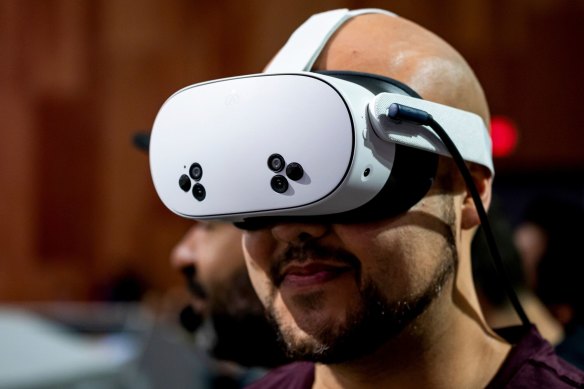This was published 9 months ago
Mark Zuckerberg shows off ‘the most advanced glasses the world has ever seen’
By Kurt Wagner and Aisha Counts
Meta debuted its first pair of augmented reality glasses – devices that show a combined view of the digital and physical worlds, a key step in chief executive officer Mark Zuckerberg’s goal of one day offering a hands-free alternative to the smartphone.
The new glasses, introduced and called Orion, look like thick, black reading glasses, but have lenses that can display text messages, video calls, and even YouTube videos onto the user’s field of vision. They are prototypes that are not for sale, but will be used internally at Meta for testing and improving the product.

Mark Zuckerberg shows off the prototype.Credit: Bloomberg
An accompanying wristband that detects nerve stimulation and cameras built into the frames that track eye movement allow Orion wearers to “click” or “scroll” on the display using just their hands.
The glasses represent nearly a decade of technological advancement and significant financial investment at Meta. They also offer a glimpse into Zuckerberg’s vision for the future of technology, which has cost the company tens of billions of dollars over the past four years alone.
Zuckerberg called the prototype “the most advanced glasses the world has ever seen.”
There is no release date for Orion – Zuckerberg called it a “glimpse of the future.”
Meta is already selling Ray-Ban branded smart glasses equipped with cameras and speakers, but Zuckerberg believes that AR glasses will become a kind of mobile, hands-free computer that could one day rival smartphones as the preferred way to communicate and interact online. If smart glasses eventually become mainstream, Meta hopes to be a major player in that new industry, which would also help the company reduce its reliance on competitors like Apple and Alphabet’s Google to deliver its products to consumers.
That goal is still years away despite the Orion prototype, which was debuted at Meta’s annual Connect conference in California. The company had hoped to make this version of the device available to the public, but executives said it’s not yet small enough or stylish enough. Those same challenges have plagued similar efforts by other tech companies over the years, including Google and Microsoft.
Snap unveiled its own pair of AR glasses earlier this month, but is only releasing them to developers.
Eventually, Meta executives believe they will be able to make the glasses thin and powerful enough that general consumers will buy them. The goal is to bring Orion to market in the “next few years” for the price of a “high-end laptop or smartphone,” said Rahul Prasad, a senior director of product management at Meta.
“Any kind of prior attempt at AR has been a headset, goggles, helmets,” he said. “We want to get to glasses.”

Meta also released a cheaper version of its Quest 3 VR goggles.Credit: Bloomberg
For now, Meta will continue to build and refine the glasses internally until they are ready for public sale. Hundreds of Meta employees have been testing the Orion glasses. The company plans to expand that group considerably now that they’ve been debuted publicly.
Unlike competing products, such as Apple’s Vision Pro headset, Meta’s Orion glasses don’t require a bulky head strap or battery pack to operate. Orion has seven cameras, including two for tracking eye movements, which allow users to control the display using visible hand gestures. Orion works best, though, when paired with an accompanying wristband, which uses electromyography to detect much more subtle hand movements so users can control the glasses with minor finger movements.
Meta designed and produced more than 10 different computer chips embedded in Orion, part of a plan to reduce energy consumption for the glasses but also to decrease the amount of heat generated so that they aren’t warm to the touch. Instead of glass, Orion’s lenses are made of silicon carbide, a material popular in some electric vehicles, which is lighter than glass and also helps bend light at extreme angles, Prasad said.
New Quest VR headset
Meta also announced a new, cheaper version of its Quest virtual reality headset, freshening its effort to persuade consumers to spend more time using virtual and augmented reality to play games, watch videos and chat with others.
The Quest 3S headset has much of the same functionality as the existing Quest 3 device but offers less memory and is several hundred dollars cheaper. The headset will be available in the US beginning October 15 and will cost as little as $US300, compared to the $US500 Quest 3 devices.
Bloomberg, AP
Get news and reviews on technology, gadgets and gaming in our Technology newsletter every Friday. Sign up here.